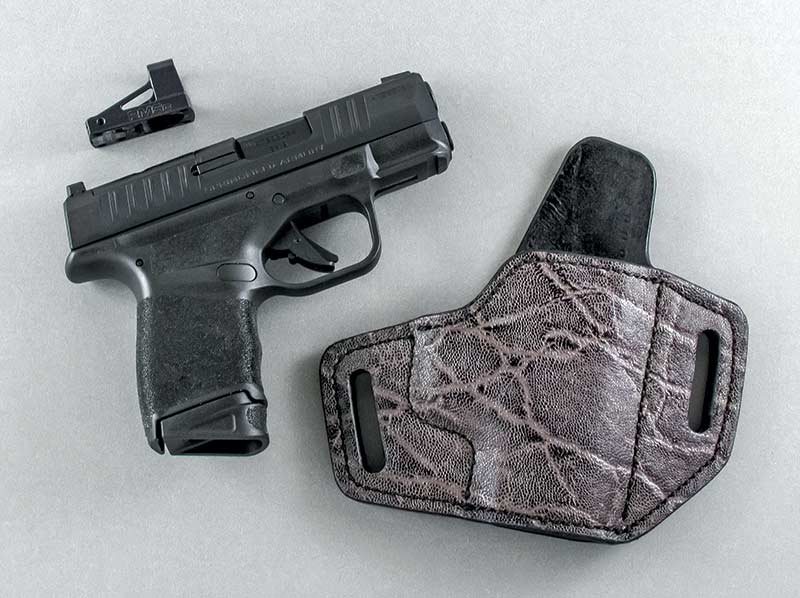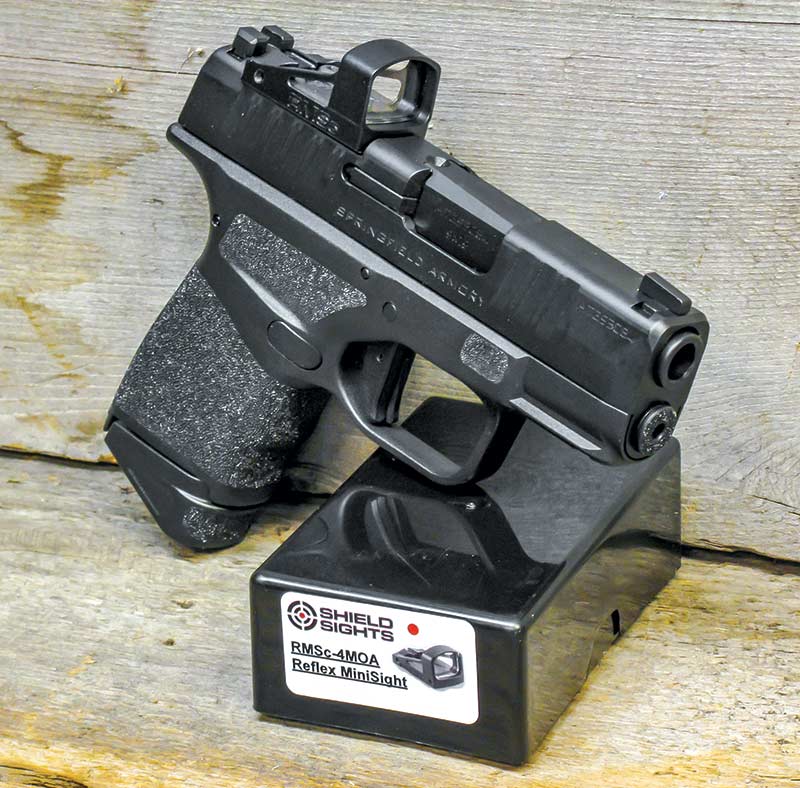A Trio Of Springfield
Armory Nines
a “classics” Guy adopts Polymer Pistols and 9mm i9iis
It’s 1980 and the sixgun is king! Most police officers carry a revolver and the vast majority of those are chambered in .357 Magnum. Thanks to Col. Cooper the .45 ACP 1911 is becoming more and more popular. The 9mm? Nobody really cares. If someone had given me 1,000 to 1 odds the 9mm would become the most popular chambering in my lifetime, I would’ve looked upon it as a sucker bet and the waste of a good dollar.
I invited a dozen plus men to gather in 1986 — an event later known as the Shootists Holiday. At this first meeting everyone brought a good six-gun or two, with one exception. A man destined to become a wonderful friend, Jerry Danuser, had the audacity to show up with a 9mm pistol — one few knew of — the GLOCK 17. And the world changed.
Today a lengthy list of manufacturers produce an even longer list of quality pistols with polymer frames. Enter Springfield Armory. While the company offers a stunning array of rifles and pistols in a plethora of calibers, let’s consider three very different 9mm introductions.
XD-M Elite 9MM
Springfield Armory’s lineup of striker-fired, polymer-framed pistols originated with the XD, later followed by the “more-features” XD-M. Offered in a variety of sizes, the family serves well as concealed carry or home-defense pistols, competition, informal target shooting or just plain plinking.
The latest family within a family is the Elite Series. As I write this, there are four basic models: the Elite 4.5″, the Tactical OSP with 5.28″ threaded barrel and optical sight mount, a shorter 3.8″ carry version, and the 5.25″ competition model.
The 4.5″ Elite weighs in at 29 oz. and has a hammer-forged 4.5″ barrel and forged steel slide, both of which are Melonite finished and matched with a black polymer frame. The slide has grooves on both sides at the front behind the front sight and at the rear in front of the rear sight making slide manipulation easy.
The polymer grip frame has aggressively molded gripping surfaces on all four sides which aids in a very secure hold. It also comes with a flared mag well which I removed for my everyday use. For me this is an everyday packin’ pistol, not a competition pistol. Springfield Armory supplies two 20-round magazines and interchangeable back straps. However, as it came it fit me just fine. The front of the frame has a molded in rail should one prefer to mount a light or laser.
It was not until after WWII when much easier to see square-notch rear sights matched up with a square front sight appeared. Now most pistols and revolvers come with good sights. The Springfield Armory Elite is an exception to the rule. It does not have good sights, it has great sights consisting of a white outline “U” shaped rear sight matched with a red fiber-optic front sight. They are exceptionally easy to see and when I extend the Elite in my shooting hand they effortlessly appear.
The new META trigger defines the new XD-M Elite family. It measures 6.5 lbs. on my Brownells Trigger Pull Gauge, feels quite smooth and releases at 90 degrees. Safety features include a trigger insert leaf and easily engaged grip safety. There is also a cocking indicator on the back of the slide and a loaded chamber indicator.
It’s still winter as I write this — at least 40 degrees below my comfort zone — so I would expect tighter groups in better weather. I’m nowhere near as tough as I used to be! I fired 10 different factory loads ranging from 115 to 147 grains in both hollow-point and full metal jacket configurations with no malfunctions of any kind. My most accurate loads at 20 yards proved to be the SIG SAUER 124-gr. FMJ at 1,215 fps and a 1″ group for five shots and the 115-gr. Blazer Brass FMJ clocking out at 1,160 fps. With its 20-round capacity as an everyday packin’ pistol I carry it with staggered rounds — a JHP followed by an FMJ followed by a JHP — making it suitable for any situation that should arise.
Hellcat Micro-Compact
The Hellcat shares its name with the venerable Grumman F6F Hellcat, a carrier-based fighter plane in the Pacific from 1943 through 1945. Dodge also uses the name Hellcat for its 2020 Challenger 717 HP and 797 HP muscle cars. So, this Springfield Armory Hellcat is in good company.
The Hellcat is at the opposite end of the size spectrum from the Elite. It’s a 17.9 oz. Micro-Compact 9mm pistol designed for pocket or holster carry and features a 3″ hammer forged barrel. It comes with two magazines with 11- and 13-round capacity. That translates to just one round short of a J-Frame with two speedloaders all in one package!
It has the same finish as the Elite and the same excellent trigger at 6.5 lbs. However, the gripping surface of the polymer grip frame is less aggressive and more like fine sandpaper. The recoil system is a dual captive recoil spring with a full-length guide rod. The sights of the Hellcat are the same as found on the Elite and just as with the Elite they are right there when I bring this little pistol up to fire. The Hellcat also comes with a base plate for mounting a red dot sight.
With its 12-round capacity the Hellcat is a formidable pocket pistol. With its light weight it’s not something I would care to spend several hours shooting, however if ever needed in a serious situation, you won’t notice the “recoil.”
Springfield Armory put me in touch with Shield Sights to equip the Hellcat with a red dot sight. I went with the RSMc 4 MOA Reflex MiniSight. The Hellcat is already set up with a removable plate in front of the rear sight which can be replaced with the proper base to accept the RSMc. This sight co-witnesses with the factory iron sights, so if something should happen to the red dot one simply uses the iron sights. This also helps to adjust the RSMc. Just set the red dot on top of the front sight before shooting to make the final adjustment. One of the great assets to this sight is the dot is always on — no need to remember to activate it when needed. Even when left in the always ready position the battery will last one to two years.
For a holster, I chose a high-riding Safari Gray Elephant Embossed leather model that rides close to the body and makes the Hellcat easily concealable. It looks good and works well with belt slots both fore and aft. This holster comes from New Pacifica Leather.
1911 Ronin Operator
Over 10 years ago, Springfield Armory sent me a full-sized stainless steel 1911 9mm. That was the beginning, and since then I’ve had extensive experience with 1911 9mms from at least six other manufacturers. The latest 9mm 1911 offering from Springfield is the Ronin Operator.
I really do like the Springfield XD series of polymer frame pistols, however my heart goes to the 1911 platform. I grew up shooting 1911s and my total affection for them will never change.
The Ronin is an especially attractive two-tone 1911 with a forged blued steel slide matched up with a forged stainless-steel frame. The 5″ stainless steel barrel is Match Grade with a 1:16 twist and a fully supported ramp. Sights consist of a red fiber-optic front sight paired with a white-dot square-notch rear sight.
Springfield Armory describes the trigger as a “streamlined and skeletonized Gen 2 Trigger designed for performance.” It has an excellent feel and measures out at four lbs. Safety features include the standard 1911 thumb safety and now standard beavertail grip safety with a memory bump. The Commander-style hammer fits into a slot on the top of the grip safety when it is cocked. The frame is checkered on the flat mainspring housing and smooth on the front. Springfield Armory checkered wooden grip panels complement the frame and slide finish nicely.
The recoil system is also standard 1911 with a bushing and no guide rod. Easy manipulation of the slide is aided by easy-to-grasp diagonal slots on both sides of the slide below the rear and front sights. The only negative I can come up with on the Ronin is the fact the magazine release is difficult to depress. If it doesn’t loosen up sufficiently with use, and it already has started to, I’m sure my gunsmith can take care of the situation. For some reason the Ronin comes with only one magazine, however, this is an easy fix.
I guess I’ve come around to the 9mm since that first Shootists Holiday back in 1986.
For more info:









